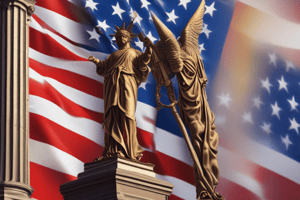Podcast
Questions and Answers
Who was the defendant in this case?
Who was the defendant in this case?
New York Times Co.
What was the topic of this case?
What was the topic of this case?
Prior restraint
What are the facts of the case?
What are the facts of the case?
Robert McNamara ordered a study, resulting in the Pentagon Papers, which Daniel Ellsburg delivered to the NYT. The NYT published content, leading Nixon to seek to stop them for national security reasons.
What was the decision of the case?
What was the decision of the case?
What was the reasoning of the court?
What was the reasoning of the court?
What theory did the Supreme Court use when deciding if this case violated 1st Amendment rights?
What theory did the Supreme Court use when deciding if this case violated 1st Amendment rights?
Flashcards are hidden until you start studying
Study Notes
Case Overview
- New York Times Co. v. United States involved significant First Amendment questions regarding prior restraint.
- The case centered around the government's attempt to prevent the publication of the Pentagon Papers by the New York Times.
Key Facts of the Case
- The Pentagon Papers were a classified study ordered by Secretary of Defense Robert McNamara about U.S. involvement in the Vietnam War.
- Daniel Ellsberg, a Pentagon analyst, leaked the documents to the New York Times out of political conscience.
- The New York Times began publishing articles based on the Pentagon Papers, igniting a legal battle with the Nixon administration.
Legal Actions
- Upon seeing the first installment, President Nixon sought to halt further publication due to concerns over national security.
- Nixon's administration claimed that the publication of the Pentagon Papers violated the Espionage Act and sought a permanent injunction against the New York Times.
Decision of the Court
- The Supreme Court ruled in a 6-3 decision that prior restraint was unconstitutional in this context.
- The Court emphasized that the government could not impose restrictions on the press without clear justification.
- The ruling reaffirmed the New York Times' First Amendment rights, allowing them to continue publishing the Pentagon Papers.
Reasoning Behind the Decision
- The Court found that claims of national security were too vague to justify a ban on publication.
- Justices argued that withholding information from the public did not equate to serving national interest; transparency was deemed essential.
- The Court did not see any immediate threat that would justify prior restraint on the publication.
Theoretical Framework
- The Supreme Court applied the Preferred Position Balancing theory, prioritizing free speech over potential government censorship.
- The burden of proof lay with the government to demonstrate why prior restraint was necessary, a high standard they could not meet.
Studying That Suits You
Use AI to generate personalized quizzes and flashcards to suit your learning preferences.




